



Weekly Outlook: Any Chance For Recovery In Crop Prices?
US - The prices of wheat and soybeans have been trending lower since late April/early May. Corn prices declined sharply last week says Darrel Good, Agricultural Economist, University of Illinois.After moving to near $5.15 in early May, July 2010 wheat futures at Chicago are now near $4.35. Similarly, November 2010 soybean futures spiked to about $9.85 in late April and are now under $9.00, the lowest since last fall. December 2010 corn futures traded in a fairly wide sideways pattern during April and May, with a spike to just under $4.00. That contract is now near $3.55, the lowest since early September 2009. Recent price declines for all three crops continue the general downward trend that began in January 2010.
A record pace of consumption of US corn and soybeans during the current marketing year and prospects for a much smaller US wheat harvest in 2010 provided some price support earlier in the year, but are now overshadowed by other factors. Crop prices have been negatively impacted by a sluggish economic recovery, high domestic unemployment rates, and increasing financial stress in Europe. In addition, a record large South American soybean crop in 2010, prospects for a third consecutive year of large wheat crops outside of the US, and prospects for a rebound in corn production in China and Mexico all point to sluggish demand for US crops in world markets.
Adding to the recent negative tone in the crop markets is the growing confidence in large US corn and soybean crops this year. Most of the corn crop was planted in a timely fashion and early growing season weather has been generally favorable. Areas of excessive precipitation and areas of dryness do exist, but crop condition ratings have been high. As of May 30, the USDA’s weekly Crop Progress report showed 76 per cent of the crop in the 18 largest corn producing states in either good or excellent condition. The range was from 45 per cent in Missouri to 92 per cent in Minnesota. Crop condition ratings were expected to remain high in the report released on June 7 and more rain is expected in the Midwest this week.
There is a tendency for early season crop condition ratings for corn to exceed the ratings at the end of the season. The average end-of-season rating from 1986 through 2009 was 63 per cent good or excellent. While current ratings may not be maintained through the season, they underscore the good start to the 2010 crop. In addition to a large crop, the market is now expecting an early corn harvest this year.
The start to the 2010 season for the US soybean crop has not been quite as favourable as for corn, with both the planting pace and crop emergence as of May 30 very near the previous five year average. The completion of planting may be further delayed by more rain this week. The first complete set of crop condition ratings were scheduled for release on June 7. A relatively high percentage of the crop is likely in good or excellent condition. Last week, Iowa reported 71 per cent of that crop in good or excellent condition. Since 1986, the end-of-season report has shown an average of only 56 per cent of the US crop in good or excellent condition.
A recovery in crop prices will require a reversal in one or more of the major factors that are currently having a negative impact. These include world economic/financial conditions, foreign crop production prospects, domestic demand, and US crop prospects. Domestic corn demand could get a boost from an approval to increase mid-level ethanol blends from the current maximum of 10 per cent. Such an increase would not be a surprise, however, and might result in only modest price support.
The other factor that began to attract attention last week was the recent end to the El Nino weather pattern and the Climate Prediction Center forecast of the possibility of a La Nina to develop over the next few months. Based on previous occurrences of such transitions, some climatologists see increased chances of more adverse growing conditions in the Midwest in July and August. Some point to 1983 as an analog year. While there does not appear to be any near term threats to crop development, summer weather prospects should continue to be monitored for any indication of a pattern shift.


